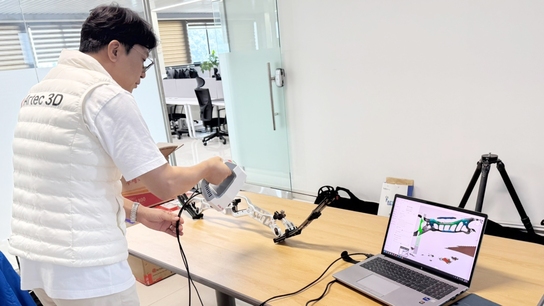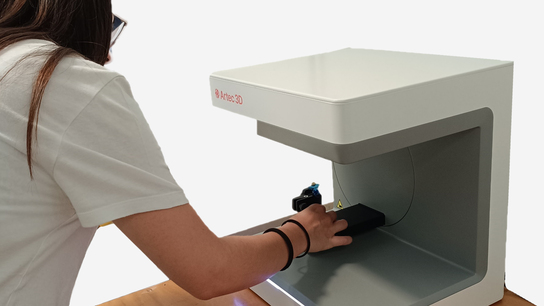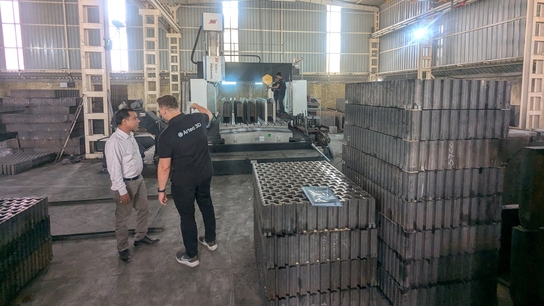Creating customized auto parts for vintage race cars with Artec Space Spider
Challenge: To get this Ruffian GT40 in perfect driving shape by designing highly specific, customized parts for it
Solution: Artec Space Spider, Artec Eva, Artec Studio, Blender, SketchUp, 3D printing
Result: A car complete with customized parts, on track for its SEMA 2021 debut!
With a background in computer games and a love for building cars, it didn’t take long for Chris Ashton to find his way into the 3D scanning world, combining both profession and passion. “I’m in 3D programs for so much of the day, which I think probably helped me understand the scanners and software – which are awesome, by the way,” he said.

A ride ready for the streets.
For Ashton, who is in the business of designing, fabricating, modifying, and building “street-able” race cars with his California-based company Ruffian Cars, it only took a half-hour walkthrough from his local dealer, Artec Certified Partner Source Graphics, to get him started. “I walked in and asked about the scanners,” he recalled. “They took me seriously and gave me a demo.”
This instilled enough confidence in Ashton’s grasp of both the hardware and software, and he went ahead with a purchase, planning to use the new tech for his car-building hobby. He walked out the door that day with two 3D scanners in hand: an Artec Space Spider and an Artec Eva. The Source Graphics team followed up with him post-purchase to make sure everything was working smoothly.

Artec Space Spider (left) and Artec Eva (right)
First designed for use on the International Space Station, as its name suggests, the Artec Space Spider is ideal for capturing small parts in great detail. Guaranteeing metrological accuracy, this industrial scanner excels at scanning fine lines, sharp edges, and complex geometry – making it ideal for everything from coins to keys, medical equipment to automotive parts and beyond.
The flagship scanner of Artec 3D, Eva is light, fast, and versatile, delivering high-accuracy scans of medium-sized objects. Perfect for use as a standalone scanner, Eva can also be combined with other Artec scanners for an all-inclusive larger scan, with comprehensive coverage of small parts and intricate details.
“I struggled for the first hour or two while getting a feel for how quickly to move the scanners, how close to be to the target, and trying to remember how the software worked, but I had a couple of decent, processed scans the first evening (a pill bottle and a garlic clove),” said Ashton. “So I went to bed happy with the investment.”
And he was just getting started.

The GT40, ready for its customized headlights.
Using Artec Eva, Ashton captured 3D scans of the entire car, while with Space Spider, he was able to zoom into separate, individual components that he wanted to integrate.

The varying geometry of the rear side of a headlight was faithfully reconstructed in this crisp Space Spider scan.
The bigger plan: to completely customize and bring to life a classic car that’s not only road-ready but also looks good enough to turn heads. “The fender flares are what initially drove me to the scanners,” Ashton said. “When I finished scanning the body, parts were imported into 3D modeling programs Blender or SketchUp, depending on what shape they are, and the flares were built as separate pieces on top of the body, then printed.”
Here’s how it works: “First, I scan the car’s original fenders, bring it into the computer and model a digital fender flare on top of it,” he explained. “Then I use a VR headset to walk around the car and look at the parts in virtual 3D, so I can make any artistic adjustments. Once I am happy with the digital files, I will print the fender flares on a large format 3D printer.”
The printed fender flares will be test fit, and then sent to another shop to create a mold from, so that they can mass-produce the parts in carbon fiber. This is a stark contrast to how his previous car was customized. While 3D printing was already in use, the process required a lot of time, testing, pattern making, and trial and error. “The big advantage here is that the fender flares were built digitally on a scale scan of the actual car so we know they’ll fit properly, and the left and right sides will be exact mirrors of each other.”

3D scans of the fenders served as a base for designing bespoke flares in Blender.
Besides a real-time look at how the customized parts will fit, this process greatly reduces the time spent as well.
“3D scanning will reduce new part development time significantly, particularly on curvy shapes that are hard to measure,” said Ashton. “In addition, I can have confidence that the first print will fit and will not have to wait for five or six 8-hour-long prints.”
“Previously I would have needed to sculpt the flares out of foam or clay, right on top of the car, and take the whole car to a shop for them to pull the molds (or do it myself, which is messy and involves a lot of chemicals.) And I would have had to do the job twice because you can’t mirror a part in the real world.”
Aneesh Joshi, 3D Solutions Lead from Source Graphics, sees a greater potential for 3D scanning in the automotive industry. “There is an ocean of unfulfilled applications which can be addressed with handheld 3D scanners,” he said. Glad to have been part of Ashton’s solution, he added, “We are grateful that we were able to be the medium to provide Ruffian Cars with a great product for use on their amazing creations.”
Over the past few months, Ashton has continued to work on the car, customizing everything from its headlights to the seat belt buckles, fenders, and side skirting.

Artec Space Spider picked up the finest details of this seatbelt clasp, down to metal stamping.
“The headlights will combine new Toyota LED headlight components with the Superformance GT40 body, to modernize the look of a classic race car,” he described.

The inner angles and curves of this headlight bucket were captured for exact measurements, which would otherwise be hard to take.
Another main advantage of working with 3D scanning is how close to reality the models created are. “Since the scans come into the computer at real-world scale, I can model my new parts around them and print them without any scale issues, which is a huge improvement over what I was doing before, which was taking measurements, building on those, and hoping they were correct,” said Ashton.

The headlight model assembled.
“Seeing the processed model is my favorite thing! It’s like magic. It was in the real world and now it’s in the computer too, and it looks the same!”

The custom-built headlight fits like a second skin.
And customizing cars isn’t the only way 3D scanning and printing has added to Ashton’s work and life. “My girlfriend bought an antique chandelier with lightbulb holders that were shaped like candles, complete with fake dripping wax down the sides,” he described. “The only problem is that it had only one bulb holder and needed eight. But now, no need to search the world over for rare replacements. I scanned the holder with Space Spider and printed seven copies!”
With customized furniture created and classy cars set for a big debut in SEMA 2021 – the premier trade show for automotive manufacturers to debut new, innovative products – 3D scanning has been a game changer for Ashton. “I learn more each time I use them, but I’ve already been able to scan the items I want, and am moving ahead full steam.”
Scanners behind the story
Try out the world's leading handheld 3D scanners.






